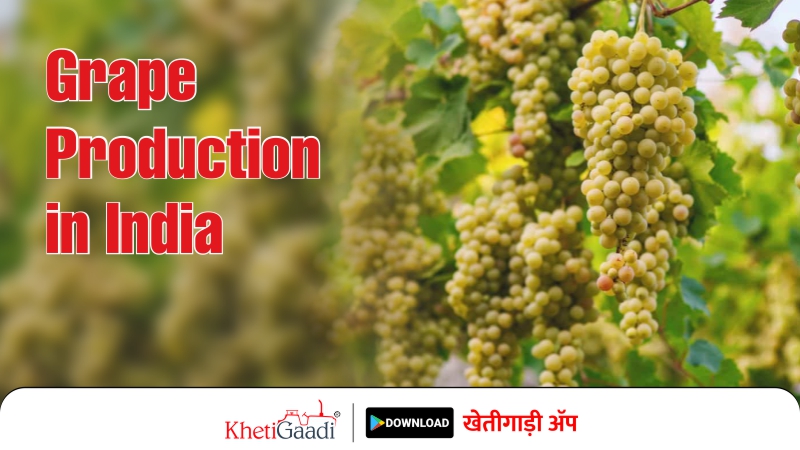India is one of the largest grape-producing countries in the world. Grapes are grown in various states across India, with Maharashtra being the largest grape-producing state. Maharashtra is the largest grape-producing state in India, accounting for more than 80% of the total grape production in the country. Other major grape-producing states in India include Karnataka, Andhra Pradesh, Tamil Nadu, and Telangana. The most widely grown grape varieties in India are Thompson Seedless, Bangalore Blue, Anab-e-Shahi, Sharad Seedless, and Manik Chaman. Grape cultivation in India is mostly done on a commercial scale, with large farms and vineyards spread across the country.
The grape season in India typically starts in December and lasts until May. The Indian grape industry has undergone significant growth in recent years, with the adoption of modern cultivation techniques, better infrastructure, and increased exports to foreign markets. The export of grapes from India has been growing rapidly in recent years. The major export destinations for Indian grapes include the United Arab Emirates, the Netherlands, the United Kingdom, Bangladesh, and Saudi Arabia. The grape industry in India faces various challenges, including disease and pest management, lack of adequate storage and transportation infrastructure, and price volatility. However, the government and private sector are working together to overcome these challenges and support the growth of the grape industry in the country.
Indian Grape Production History
Grapes have been cultivated in India since ancient times. According to archaeological evidence, grape cultivation in India dates back to around 1300 BC. The first mention of grape cultivation in India can be found in ancient Indian texts such as the Rigveda and the Mahabharata. Historically, grape cultivation in India was concentrated in the northwest region of the country, particularly in the states of Maharashtra and Karnataka. In the early 20th century, a disease known as phylloxera devastated grape production in India, and it wasn’t until the 1960s that grape cultivation began to recover. Since then, the Indian grape industry has grown significantly. Today, India is one of the top grape-producing countries in the world, with over 2 million metric tons of grapes produced annually. Maharashtra is the largest grape-producing state in India, accounting for more than half of the country’s total grape production. The majority of grapes grown in India are table grapes, which are sold fresh for consumption. However, India also produces a significant amount of grapes for wine production, particularly in the state of Maharashtra. The Indian government has implemented policies to support the growth of the grape industry, including subsidies for grape farmers and initiatives to improve grape processing and storage facilities.
Soil Condition for Grapes in India
The soil condition for grapes in India varies depending on the region and the type of grape variety being grown. Generally, grapes require well-drained soils with good fertility and adequate water-holding capacity. The ideal pH range for grape cultivation is between 6.0 and 6.5. In Maharashtra, which is the largest grape-growing state in India, the soil type is predominantly sandy loam with a pH range of 6.0 to 8.0. The soil is usually low in organic matter and nitrogen, and farmers often apply organic manure and fertilizers to improve soil fertility. In the Nashik region of Maharashtra, which is known for producing high-quality grapes, the soil is red laterite soil with good drainage. In Karnataka, another major grape-growing state, the soil type is varied and includes red laterite soil, black soil, and sandy loam. The ideal pH range for grape cultivation in Karnataka is between 6.0 and 7.5. In Andhra Pradesh, the soil type is predominantly red soil and black soil, with a pH range of 5.5 to 7.5. These soils are rich in iron, but farmers often add organic manure and fertilizers to improve soil fertility. Grapes can be grown in a wide range of soil types as long as they have good drainage and are adequately fertile. It is important to conduct soil tests and consult with local experts to determine the best soil conditions for grape cultivation in a particular region.
Weather production in India
India’s weather is influenced by a variety of factors, including its location in the tropics, the Himalayan mountain range, and the Indian Ocean. The country experiences a diverse range of weather patterns and seasons, which can vary significantly depending on the region.
India’s climate can be broadly classified into six distinct climatic regions:
- The Himalayan mountain region, which experiences a sub-Arctic climate in the high altitudes, and a subtropical climate in the lower valleys.
- The northern plains, which have a continental climate with hot summers and cold winters.
- The Thar Desert, which experiences a hot and arid climate.
The western coastal region, which experiences a tropical monsoon climate with heavy rainfall during the monsoon season.
- The eastern coastal region, which also experiences a tropical monsoon climate, but with less rainfall than the western coast.
- The southern peninsula, which has a tropical climate with high humidity and moderate to heavy rainfall.
India’s monsoon season is a crucial aspect of its weather patterns. The monsoon typically lasts from June to September, bringing much-needed rainfall to the country’s agricultural sector. However, the monsoon season can also bring flooding and landslides, causing damage to infrastructure and property.
India’s weather patterns are complex and varied, and understanding them is essential for planning and managing various aspects of the country’s economy and infrastructure.
States Producing Grapes in India
Grapes are primarily grown in India in the states of Maharashtra, Karnataka, Andhra Pradesh, Telangana, Tamil Nadu, and Punjab. Maharashtra is the leading producer of grapes in India, accounting for around 81% of the total grape production in the country. The Nashik and Sangli districts in Maharashtra are known for their grape production. Other states like Karnataka, Andhra Pradesh, Telangana, Tamil Nadu, and Punjab also produce significant quantities of grapes.
Top Districts of Maharashtra in Grape Production
Maharashtra is the leading grape-producing state in India. Some of the top grape-producing districts in Maharashtra are:
Nashik: Nashik is the largest grape-producing district in Maharashtra, a state located in western India. Nashik is known for its grape cultivation and is sometimes referred to as the “Wine Capital of India”. The city has a long history of grape farming, and its favourable climate and soil conditions have made it a prime location for grape cultivation and produce a wide variety of grapes including Thompson Seedless, Sharad Seedless, Sonaka, and Manik Chaman.
In addition to grapes, Nashik also produces other fruits and vegetables, including onions, tomatoes, and pomegranates. The district is an important agricultural center in India and is known for its contribution to the country’s food industry. The annual grape production of Nashik varies from year to year depending on various factors such as weather, farming practices, and market demand. However, according to recent estimates, Nashik produces around 1.5 million metric tons of grapes annually.
According to the data available from the Ministry of Agriculture and Farmers’ Welfare, the annual grape production in Nashik district was around 1.68 million metric tonnes (MMT) in the year 2019-2020. However, it is important to note that grape production can vary from year to year depending on various factors such as weather conditions, pest infestation, and disease outbreaks.
Sangli: Sangli is indeed the second largest grape-producing district in Maharashtra, a state located in western India. It is known for its fertile soil and favourable climate conditions, which make it ideal for grape cultivation. Sangli is situated in the Western Ghats mountain range and is part of the Deccan plateau. The district is home to several grape varieties, including Thompson Seedless, Sharad Seedless, Manik Chaman, and Sonaka. Grapes are a significant agricultural crop in Sangli, with many farmers depending on them for their livelihoods.
The district is also home to a large number of wineries, which produce a variety of wines from the grapes grown in the area. The grape-growing season in Sangli generally starts in January and continues until May. The grapes are harvested during this period and are sold both in domestic and international markets.
According to the data from the Ministry of Agriculture and Farmers’ Welfare, Government of India, the annual grape production in Sangli for the year 2020-21 was around 6.86 lakh tonnes (686,000 tonnes) from an area of 70,200 hectares.
Solapur: Solapur is a district in the state of Maharashtra, India. It is known for its grape production and is considered one of the major grape-growing regions in India.
Grape cultivation in Solapur has a long history, dating back to the 19th century when the British introduced grape farming in the region. The district’s favorable climate and soil conditions, combined with modern cultivation practices, have made it a hub for grape production in India.
The main grape varieties grown in Solapur are Thompson Seedless, Sharad Seedless, Sonaka, and Tas-A-Ganesh. These grapes are mainly used for table consumption, juice production, and wine-making.
The grape season in Solapur starts in December and lasts until April. During this time, the district is bustling with grape farmers and traders who come to buy and sell grapes. The grapes are harvested manually and transported to markets across the country.
Grape cultivation in Solapur has not only helped in the economic growth of the region but has also provided employment opportunities to the local population. It has also put Solapur on the map as a major grape-growing region in India.
Pune: Pune is a city in the western Indian state of Maharashtra, and it is also the name of a district in the state. The district of Pune is known for its production of grapes, which are grown in the hilly areas surrounding the city. The grapes produced in this region are of high quality and are used to make a variety of products, including wine and raisins.
The climate and soil conditions in the district are ideal for grape cultivation, and as a result, grape cultivation has become an important part of the local economy. Other crops grown in the district include sugar cane, wheat, and vegetables. The district produces a wide variety of grapes, including the popular varieties of Thompson Seedless, Sonaka, and Sharad Seedless.
An annual grape production of around 200,000 metric tons. Grapes are grown in the region mainly for table consumption and wine production.
These districts have favourable climatic conditions and soil quality for grape cultivation, which has contributed to their high production levels.
Get information related to tractors, tractor videos, and tractor games; and visit the Khetiguru mobile application for farming-related updates.




